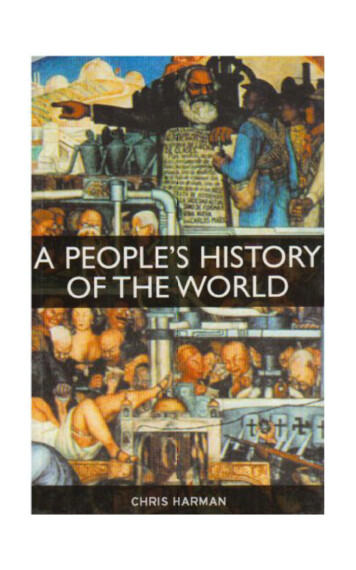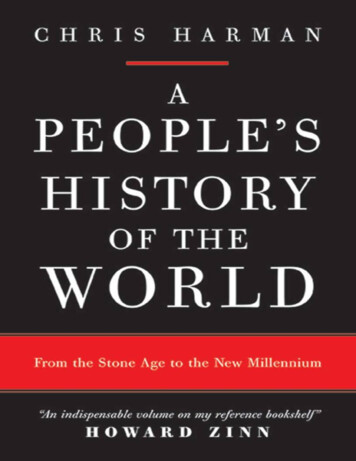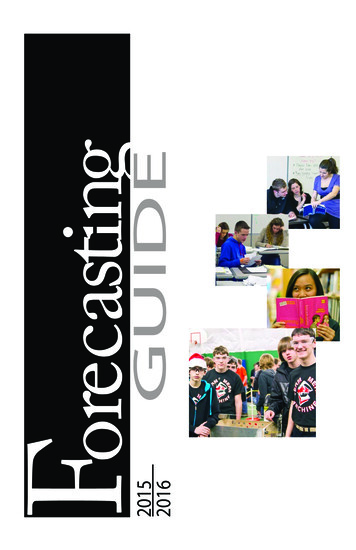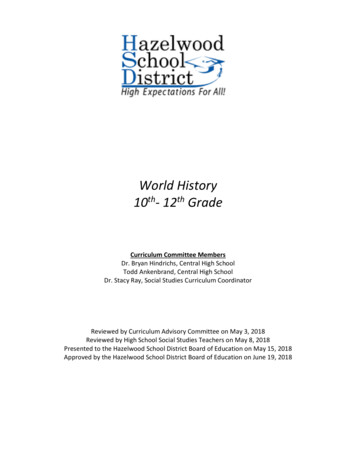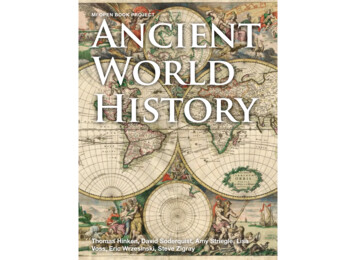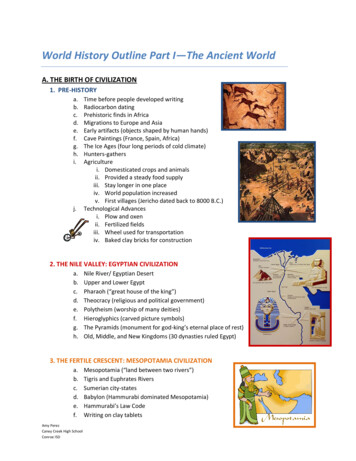
Transcription
World History Outline Part I—The Ancient WorldA. THE BIRTH OF CIVILIZATION1. PRE-HISTORYa.b.c.d.e.f.g.h.i.j.Time before people developed writingRadiocarbon datingPrehistoric finds in AfricaMigrations to Europe and AsiaEarly artifacts (objects shaped by human hands)Cave Paintings (France, Spain, Africa)The Ice Ages (four long periods of cold climate)Hunters-gathersAgriculturei. Domesticated crops and animalsii. Provided a steady food supplyiii. Stay longer in one placeiv. World population increasedv. First villages (Jericho dated back to 8000 B.C.)Technological Advancesi. Plow and oxenii. Fertilized fieldsiii. Wheel used for transportationiv. Baked clay bricks for construction2. THE NILE VALLEY: EGYPTIAN CIVILIZATIONa.b.c.d.e.f.g.h.Nile River/ Egyptian DesertUpper and Lower EgyptPharaoh (“great house of the king”)Theocracy (religious and political government)Polytheism (worship of many deities)Hieroglyphics (carved picture symbols)The Pyramids (monument for god-king’s eternal place of rest)Old, Middle, and New Kingdoms (30 dynasties ruled Egypt)3. THE FERTILE CRESCENT: MESOPOTAMIA CIVILIZATIONa.b.c.d.e.f.Amy PerezCaney Creek High SchoolConroe ISDMesopotamia (“land between two rivers”)Tigris and Euphrates RiversSumerian city-statesBabylon (Hammurabi dominated Mesopotamia)Hammurabi’s Law CodeWriting on clay tablets
g. Ziggurats (temple made as a series of terraces of sun-dried brick)h. The Phoenicians (merchants of the Mediterranean)i. The Israelite Nation (Abraham, Moses, David, Hebrew Exile andReturn)j. The Hittites (around 2000 B.C. conquered Asia Minor)k. Assyrians (a lethal fighting force in the Middle East)l. Persian Empire (Cyrus, Darius, Xerxes—controlled the Middle East,Asia Minor, and N. India)4. THE INDUS & GANGES: EARLY INDIAN CIVILIZATIONa. Geographical feature that encouraged settlement- Indus River Valley (broad flat plain)b. Twin cities of Mohenjo-Daro and Harappa around 2500 B.C.i. Centrally planned citiesii. A citadel overlooked each cityiii. Grid pattern of straight streetsiv. Oven-baked bricksv. Some houses several stories highvi. Enclosed courtyardsvii. Bathrooms with drains and chutes connected to abrick sewer system beneath the streetsviii. Written languageix. Traded and developed industry (tools, jewelry,mass-produced clay pots, traded withMesopotamia)c. Aryans Invade Indus Valley around 1500 B.C.i. Indo-European group- areas north of the Black andCaspian Seasii. Civilization based on agriculture and handicraftsiii. Religion based on Vedas (collection of books originating in Ancient India)d. Hinduism grew out of Vedase. 1500 B.C. to 1000 B.C. called Vedic Agef. Epic Ageg. Hinduism developedi. Universal Spiritii. Cycle of Rebirth (Karma)h. Buddhism was introduced by Gautama “Buddha”i. The Four Noble Truths1. All People Suffer2. People suffer because their desires bind them to the cycle of Rebirth3. People could end their sufferings by eliminating their desires4. Follow the Eight Fold PathAmy PerezCaney Creek High SchoolConroe ISD
i.The Eight Fold Pathi. Know the Truthii. Resist eviliii. Say nothing to hurtothersiv. Respect Lifev. Work for the goodof othersvi. Free mind of evilvii. Control thoughtsviii. Practice Meditationj. By following the Eight FoldPath, a person could attain nirvana- a state of extinction (universal spirit) and freedomfrom rebirthk. Golden Age of the Guptasi. The Mauryan and Gupta Empiresii. Maurya Empire founded by ChandraguptaMaurya about 312 B.C.iii. Grandson Asoka converted to Buddhismiv. Chandragupta I (not related to ChandraguptaMaurya) built the Gupta Empire about A.D. 310v. Golden age of literature, art, architecture,mathematics, and medicine5. YELLOW RIVER VALLEY: EARLY CHINESE CIVILIZATIONa. Yangtze River encouraged settlementb. Himalayas and Gobi Deserts- encouragedisolationYangtze Riverc. Chinese civilization evolved throughchanging dynasties and emphasis oninvention and the artsd. Shang Dynasty about 1500 B.C. to 1000B.C.i. Pottery from kaolin- fine white clayii. Bronze castings (daggers, figures,urns, cauldrons)iii. Developed a written scripte. Zhou, Qin, and Han Dynasties (800 years)i. Strong central governmentii. The Great Wall of China (4,000 miles; the Qin Dynasty)Amy PerezCaney Creek High SchoolConroe ISD
iii. The Silk Road and PaxSinica (400 years ofprosperity and peaceunder the Han dynasty)iv. Philosophy flourishedSilk Road Map6. GREECEa. Aegean Areai. Mountainous peninsulaii. Interior plainiii. Rugged coastlineb. Early Peoplei. Minoans1. At Knossos on Creteii. Mycenaeans1. Indo-European peoples of centralAsia2. Invade Greece about 2,000 B.C.3. Mycenae- capitolc. Homer, authori. Iliadii. The Odysseyd. Polis—city-statei. Free citizensii. Direct democracyiii. Minority of residents were citizense. Greek Colonies and tradei. A “parent city”ii. Colonies located on coast of the Black and theMediterranean Seasiii. Supplied overcrowded Greek mainland with grainiv. Greece supplied wine, olive oil, etc.f. Spartai. Totalitarian, authoritarian, militaristicg. Athensi. “Birthplace of Democracy”h. Greeks and Wari. Persian (Persian invasion and Marathon, 490 B.C.)ii. Peloponnesian War (Sparta vs. Athens)1. Sparta eventually wins2. Weakens and divides GreeceAmy PerezCaney Creek High SchoolConroe ISD
i.Amy PerezCaney Creek High SchoolConroe ISDContributions to Civilizationsi. Greece’s Golden Age- Fifth Century B.C.ii. Writers1. Herodotus- Histories2. Thucydides- Peloponnesian Wariii. Drama1. Aeschylus- the Oresteia2. Sophocles- Oedipus Rex3. Euripides- The Trojan Women4. Aristophanes- The Clouds (comedy)iv. Art1. Wall painting2. Sculpture3. Vasesv. Philosophy1. The Sophists- professional teachers2. Socrates3. Plato- The Republic4. Aristotle- Ethics, Politicsvi. Mathematics1. Thales of Miletus2. Pythagorasvii. Medicine1. Hippocrates2. Disease had natural, notsupernatural, causes andcuresviii. Architecture1. Simplicity, balance, and perfection2. Columns
j.ix. Olympic Games1. Athletics stressed in school curriculum2. Held every 4 years at Olympia in honor of Zeus3. Athletes came from Greek speaking world to compete4. Trading and fighting stopped during the gamesAlexander the Great and Hellenismi. Phillip II of Macedonia (Alexander’s father)ii. Conquered Greece (Greece weakened by the Peloponnesian War)iii. Alexander the Great (20 years old) 336 B.C. (died: 323 B.C.)iv. Conquered Asia Minor, Egypt,Persia, northern Indiav. Spread Greek language andculture (mixed with MiddleEastern culture)vi. Kingdom divided1. Ptolemy (Egypt, Libya,and parts of Syria)Alexander’s Empire2. Selecus (rest of Syria,Mesopotamia, and Iran)3. Antigonus (Macedonia and Greece)7. ROMEa.b.c.d.e.f.g.h.Located along the Tiber RiverThe Etruscans (ruled northern Italy from the plains of Erturia)City-state (Rome)Patricians (wealthy aristocrats)Plebeians (non-aristocrats)Republic form of government with a constitution (12 Tables)Conquest of ItalyThe Punic Warsi. Rome and Carthageii. Hannibaliii. Carthage defeatedi. Slaveryj. Rome grew as a Mediterranean powerthrough a series of strong militaryleadersk. Roman rule (government, law, and animperial army)l. Roman Imperialism (the Roman Legions)Amy PerezCaney Creek High SchoolConroe ISD
m. Imperial Romei. Assassination of Julius Caesarii. Civil Wariii. Actium, Greece (31 B.C.)iv. Octavian becomes Augustus (“Majestic One”) Caesar (27 B.C.)n. The Rise and Spread of ChristianityJuliusi. Jesus ChristCaesarii. Paul- spread Christianity across Roman Empire, writingsform part of New Testament in Bibleo. The Empire’s Problemsi. Political Instabilityii. Economic Declineiii. Over-expansion-- division into twoiv. Barbarian Invasionsp. The Fall of the Empire in the West (A.D. 476)q. Roman Contributionsi. Philosophyii. Lawiii. Engineeringiv. Architecturev. Sculpturevi. Artvii. Literature1. Marcus Cicero, Virgil, Plutarchviii. Medicineix. Military StrategyTHE ROMAN EMPIREAmy PerezCaney Creek High SchoolConroe ISD
8. AFRICAa.b.c.d.Regions: North, East, West, Central, and South AfricaNubia (Upper Nile River) (3000 B.C.)Kush (Upper Nile River; strong trade economy) (2000 B.C.)Axum (near the Red Sea; strong trade economy) (about 200 B.C.to A.D. 600)e. Bantu migrations (mass migrations throughout the continent)f. Kingdoms in West Africai. Ghana (between A.D. 300- 1200; trading empire; 100,000square miles)ii. Mali (about A.D. 1200s to 1500s)iii. Songhai (about A.D. 1400s to 1600)9. DEVELOPMENT OF CIVILIZATIONa.b.c.d.e.f.g.Nearness to water (drinking, transportation)Centrally located (long distance trade)Mild climateFertile land and adequate rainfallDefensible positionAgriculture (plows, oxen, irrigation)Specialization of labor (artisans—workersskilled in a craft)h. Invention of Writingi. Systems of Values10. CHARACTERISTICS OF ESTABLISHED CIVILIZATIONSa.b.c.d.e.f.g.h.i.Amy PerezCaney Creek High SchoolConroe ISDGovernmentDivision of LaborLearned personsCapital goodsTownsTransportation structuresMilitaryEfficient food production(agriculture)Defined culture
World History Outline Part I—The Ancient World A. THE BIRTH OF CIVILIZATION 1. PRE-HISTORY a. Time before people developed writing b. Radiocarbon dating c. Prehistoric finds in Africa d. Migrations to Europe and Asia e. Early artifacts (objects shaped by



